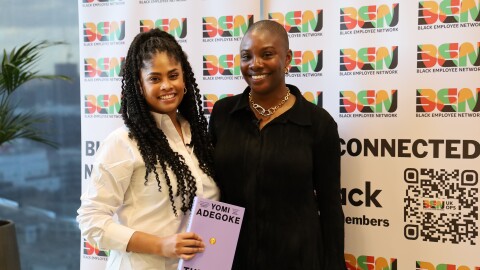When Hexen Wilson – a solutions architect for AWS – found themself questioning their sexuality, they reached out to their manager to assist in coming out to colleagues. The support that Hexen received inspired them to reach out to other managers to share their story and present some advice and best practice for those who may be managing non-binary employees.
Can you tell us about your path towards coming out as non-binary?
Many of us went through a journey of self-discovery during the pandemic, and for me, it was no different. It took months of introspection brought on by lockdown to reach a place where I realised I wasn’t comfortable using either gender.

That time alone, coupled with an ADHD diagnosis and the courage of a colleague revealing their true self at work, brought me to a place where I felt comfortable and confident enough to come out to friends and family, and my colleagues and clients at Amazon Web Services (AWS).
This isn’t a very well travelled path by LGBTQ+ people in the workplace. A recent Stonewall report found that over 35% of LGBT+ people in the UK still feel reluctant to share their sexuality at work due to concerns over discrimination.
The report also found that 28% of LGBTQ+ people have at some point considered leaving their jobs because of hostile work environments; a disappointing statistic when you think about it. I’m hoping that by writing about my experiences and giving some advice, I can help guide others to be their authentic selves, and guide businesses to be as supportive as possible of their employees.
How did you come out as non-binary to your coworkers?
Over the last year I struggled with my gender identity, going by two different names on different days. Luckily, I was supported by my team and manager, and no one asked me difficult questions that I wasn’t ready to answer.
While I was going through this, a director at Amazon sent around an email to announce that a colleague of mine was coming out as trans. For me it was inspiring to see the issue being taken seriously, and to see such open communication – that acceptance at a wider level helped me to embrace my own journey.
I came out by introducing myself in a presentation using a neutral non-binary name and then followed up with my manager and team afterwards. I then worked closely with my manager and HR to make my announcement to the wider team for visibility, then changed my name and pronouns on our numerous IT systems.
Management and colleagues were supportive from the get-go, and I’ve really come to admire the growing culture of inclusivity at AWS. I was shown Amazon’s transgender toolkit, a fantastic document developed in partnership with our LGBTQ+ affinity group Glamazon, that guides trans colleagues through the process of transitioning in the workplace, while showing other Amazonians how best to support them.
What advice can you give to those who manage non-binary employees?
Little steps made all the difference in my journey. For employers out there reading my story, and for those wanting their own employees to feel encouraged to be themselves, I have a few pieces of advice:
Pursue inclusivity as a culture and be willing to learn how you can do better. This includes making mistakes, and owning them, and building those learnings into future plans. Embedding a learning culture helps. Education can come from others in your circle or online and can be as simple as asking questions (when appropriate) if you’re unsure of something. The internet is a wonderful resource for finding out more and for accessing support for yourself or for employees.
From my background working in IT, I would say that companies should make sure any systems you utilise have options to set preferred names or pronouns, rather than just the traditional male/female and he/she pronouns. That can be easily expanded to putting pronouns on presentations, emails and work documents. Legally changing a name is a lengthy process that involves a lot of administration, but by doing this internally you allow someone to better express themselves while they wait for any legal processes to take place.
If you have dress codes, allow them to be gender non-specific. You can still set a standard for employees, while still allowing them freedom of expression through the language you use. For example, instead of stating 'males can wear a smart shirt while females can wear blouses', employers can state 'employees can choose to wear a smart shirt or blouse'.
Bathroom policies are also a hot topic when discussing issues of gender expression and identity in the workplace. Create guidance on allowing for either gender-neutral bathrooms or allowing those who identify as trans or gender non-conforming to choose which they wish to use.
Why are these changes important to non-binary employees?
Fundamentally, these are all ways to support colleagues who are going through their own journeys in different ways and at different speeds. For some of us, gender is a fluid concept and there is no one way to do things, some may want to keep their gender identity quiet or some may wish to be loud and proud about it. If you know of an individual who is going through this process, discuss with them how widely known they would like this to be.
The final point would be to ensure that these matters and any raised issues be taken seriously by the management team and HR, along with colleagues. Coming out to an employer is a big step, and by showing you take the matter seriously you will support your employees and make them feel more comfortable working with you.
Not all of the above are immediately achievable, some are trickier than others! But if employers can work to take small steps in the right direction, then they’ll encourage their employees to feel comfortable and thrive at work.
And for those feeling in a similar situation to myself a few months back, do what feels right for you. You have the right to choose when and how to make your introductions, whether quietly and slowly, or suddenly and loudly! You are in control of your own journey, no one else.
Learn more about Diversity at Amazon











